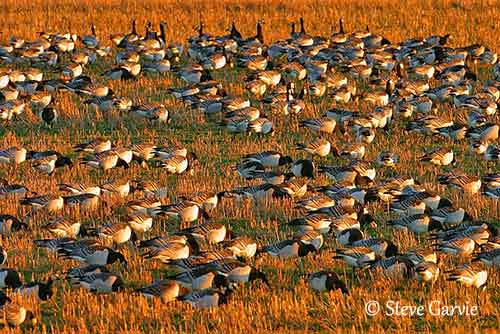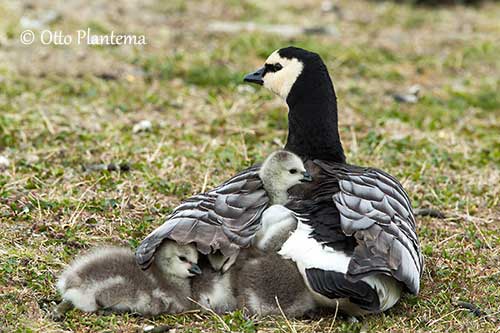
Fr: Bernache nonnette
Ang: Barnacle Goose
All: Weißwangengans
Esp: Barnacla Cariblanca
Ita: Oca facciabianca
Nd: Brandgans
Sd: Vitkindad gås
Photographers:
John Anderson
John Anderson Photo Galleries
Didier Buysse
Vision d’Oiseaux
Steve Garvie
RAINBIRDER Photo galleries & Flickr Rainbirder
Otto Plantema
Trips around the world
Nicole Bouglouan
PHOTOGRAPHIC RAMBLE
Text by Nicole Bouglouan
Sources:
HANDBOOK OF THE BIRDS OF THE WORLD vol 1 by Josep del Hoyo-Andrew Elliot-Jordi Sargatal - Lynx Edicions - ISBN: 8487334105
ENCYCLOPEDIE DES OISEAUX DE FRANCE ET D’EUROPE – de Peter Hayman et Rob Hume - Flammarion – ISBN : 2082009920
GUIDE DES CANARDS, DES OIES ET DES CYGNES – de Steve Madge - Delachaux et Niestlé - ISBN: 2603013769
THE COMPLETE BOOK OF BRITISH BIRDS – Written by “Royal Society for the Protection of Birds” experts - Préface de Magnus Magnusson - Michael Cady- Rob Hume Editors - ISBN: 0749509112
THE HANDBOOK OF BIRD IDENTIFICATION FOR EUROPE AND THE WESTERN PALEARCTIC by Mark Beaman, Steve Madge - C. Helm - ISBN: 0713639601
Animal Diversity Web (University of Michigan Museum of Zoology)
What Bird-The ultimate Bird Guide (Mitchell Waite)
Wikipedia, the free encyclopaedia
Science, Superstition and the Goose Barnacle
Barnacle Goose
Branta leucopsis
Anseriformes Order – Anatidae Family
INTRODUCTION:
The Barnacle Goose is highly gregarious in winter and forms large feeding flocks. This small goose is often considered the loveliest of all geese. This species breeds in Arctic regions, usually in barren rocky areas.
The Barnacle Goose is known for its breeding behaviour, when the small three-day old chicks follow their parents and leap from the nest high on cliff to the ground below to find food. Their small size and soft down help to reduce injury during the fall. However, numerous are hurt while landing, becoming easy preys for the Arctic Fox. They migrate to their wintering areas in family groups.
There are four main migratory populations that breed and winter in different regions. The species is today fully protected throughout its range, although suffering from disturbance and predation by Arctic Fox, Polar bear and Peregrine Falcon.
But the Barnacle Goose is currently considered not globally threatened.

LEGEND:
The Barnacle Goose is mentioned in some legends, medieval bestiary and other tales. A medieval legend mentions a tree which gives birth to birds, talking about the Goose Barnacle (Lepas anserifera), a shell living attached to floating timber. At close range, these white shells on black stalks are fairly similar to the neck of a goose.
The Barnacle Goose was a mystery in the Middle Ages, because few humans saw where it nested. The black and white barnacles floating on pieces of driftwood were compared to these geese that did not have nest at all. The legend said that these shells must be fruits that, when ripe, were able to give birth to the geese. A legend was born…

DESCRIPTION OF THE BIRD:
Biometrics:
Length: 58-71 cm
Wingspan: 132-145 cm
Weight: M : 1500-2200 g – F : 1300-1900 g
The Barnacle Goose adult has black crown, neck and breast. The upperparts are barred grey and black. Rump sides and uppertail-coverts are white and the rounded tail is black. On the upperwing, flight feathers are black with grey inner web, scapulars are pale grey and wing-coverts are grey with black and white tips.
The underparts are much paler, with flanks slightly barred pale grey. On the underwing, wing-coverts are pale grey. Undertail-coverts are white and join the white sides of the rump.
On the head, bill base, lores and eye area are black. Except the black crown and nape, the head is white, or sometimes buffy-white.
The short bill, legs and webbed feet are black. The eyes are dark brown.
Male and female have similar plumage, but the male is slightly larger than the female.


The juvenile is duller and paler. The neck is greyer instead of black, and the white parts of the head are flecked with grey. It is tinged brownish above and the flanks are washed pale buff. It reaches the full adult size in the second year of its life.
RANGE:
The Barnacle Goose breeds in E Greenland, Svalbard (Spitsbergen), Novaya Zemlya and some other locations in NW Siberia, Scandinavia and Baltic area. Some birds are recorded breeding in Franz Josef Land.
The Greenland birds winter in Ireland and W parts of Scotland. The Svalbard birds winter in the Solway Firth between England and Scotland. The eastern populations winter along the W coasts of Germany and The Netherlands.
There are some feral populations in S Britain. This species can be seen sometimes on the E coast of North America.

HABITAT:
The Barnacle Goose breeds in coastal tundra of high Arctic, usually on cliffs, crags, rocky outcrops and steep slopes, often near water such as rivers and waterbodies. It also breeds on small islands according to the range.
They can be seen in wet moss meadows and mudflats during summer.
The Barnacle Goose winters in coastal pastures, mudflats and saltmarshes, and on grassy islands.

CALLS AND SONGS: SOUNDS BY XENO-CANTO
The Barnacle Goose forms noisy flocks in winter. The grazing birds utter high-pitched, chattering “hogog, hogog” interspersed with some louder notes. In flight, short, high, barking notes are rapidly repeated.
When a predator is approaching, they give rapid, loud, monosyllabic calls, fairly similar to the yapping of small dogs.
During the mating season, mates strengthen the pair bonds by performing duets often accompanied by visual displays.

BEHAVIOUR IN THE WILD:
The Barnacle Goose feeds mainly on grass, stems, leaves, aquatic vegetation and agricultural crops. During the breeding season, it feeds on the available vegetation in the tundra, and more than 50 plant species have been identified in diet in Svalbard. In autumn-winter, it feeds on various plants supplemented by grass and herbs, grain and sugar beet.
Like most geese, it forages mainly by grazing above-ground plant material.

The Barnacle Goose is monogamous with long-term pair bonds. The pair forms in early spring. The male displays to attract a female, calling and changing postures during the triumph ceremony. It gives loud calls while moving its head. If the female is interested, she responds with loud calls while the male intensifies its movements and tries to approach the female.
Displays by male can be exaggerated towards a nearby female. It flicks its wings and lowers the head closer and more parallel to the ground. Its goal is to touch the female with its bill. If the male is accepted, it chases away all the nearby males. This display is repeated each year to strengthen the pair bonds.


The Barnacle Goose leaves the breeding grounds in late August/September to reach the wintering areas. Stopovers are closely related to weather conditions.
The Greenland population makes a stop in Iceland during four weeks before to reach Scotland. The Svalbard population makes a stop on the W coast of Norway before to continue to the W coast of England.
They return to their breeding grounds in April/May.

The Barnacle Goose has strong, direct flight with steady wingbeats. The flocks fly in V-shaped formation.


REPRODUCTION OF THIS SPECIES:
The breeding season takes place in spring, in late May/June. The female builds the nest, often a shallow depression lined with grass, moss, lichens and down. But numerous birds nest on cliff ledges in order to avoid nest-predators. The nest is made with dead leaves and mud, and lined with down prior to the laying. They also nest on the ground on coastal islands.
The Barnacle Goose breeds in colonies of 5/50 pairs, but also as isolated pairs.
The female lays 3-5 white eggs, and incubates during 24-26 days, while the male guards her and the nest. At hatching, the chicks have greyish-brown down above and whitish to yellow below. Bill and feet are black. They are precocial and leave the nest very soon, when their down has dried. They follow their parents to well-vegetated marshes where they feed themselves, under the protection of the adults. They are independent at 40/45 days old.


However, when the nest is placed on high cliff ledge, the chicks must make a giant leap from the clifftop to the ground below to find food. As the three-day old chicks are unable to fly, they jump off the cliff and fall over several tens of metres before to reach the ground, after several impacts against the rocks. Both parents wait for them at cliff foot. As soon as the chicks are ready to walk, they lead them to wet feeding areas.
Injured or dead chicks are taken by the Arctic Fox on the ground. Numerous chicks are injured when they hit the rocks, or die from the impact, but good numbers survive.
See the link: BBC Life Story


PROTECTION / THREATS / STATUS:
The Barnacle Goose is fully protected throughout the range, after adults, eggs and down were once exploited by humans. The species could be threatened by persecution by farmers when the wintering geese are grazing in pastures used for livestock. The Arctic Fox is an important predator in Svalbard.
The global population was estimated 80,000/95,000 individuals in 1980s, and this population has increased (2006).
Svalbard: 13,700 increasing to 30,000 in 2008/2009.
Greenland: 32,000 increasing to 70,500 in 2007/2008.
Russia: 400,000 individuals in 2004, increasing to 770,000 individuals in 2007/2008.
The Barnacle Goose is currently evaluated as Least Concern.
